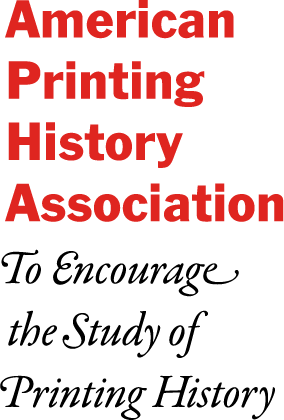Life on Mars?
Zoe Webb

Thomas Bewick, “Cameleopard” block from A General History of Quadrupeds, eighth edition, 1824. (Special Collections, J. Willard Marriott Library, University of Utah)


Thomas Bewick, “Cameleopard” block from A General History of Quadrupeds, eighth edition, 1824. (Special Collections, J. Willard Marriott Library, University of Utah)

Johan Solberg shared his recent research on historical papermaking in Central Asia, the geographical conduit through which paper technology moved from the Eastern world to Europe over a thousand years ago. Few sources remain to shed any light on how paper was made in the region when it first appeared there in the seventh or eighth century; the lack of available scholarship led Solberg to plan a trip to Uzbekistan in search of answers. [Read more]

Catherine Liu preparing dyes (Amy Childress)
Ms. Liu started her demonstration by showing participants previous printing experimentations she had created. To create her inks, Liu uses natural dye extracts, water, mordants and Akua Intaglio Transparent Base, which is a hybrid of water and oil based inks. Some of the collagraph prints she shared, showed how different natural dye and mordant inks react with different metal surfaces. It was really exciting to see her experimentations. Liu then showed participants how to prepare the dyes and mordants to create concentrated liquids that could then be mixed with the ink. [Read more]

Johannes Regiomontanus, Calendarium, (Venice: Erhard Ratdolt, 1476), showing built-in paper instruments: a lunar volvelle and a quadrant, and a sundial. (Art Institute of Chicago. Gift of Emil Eitel in memory of Mrs. Emil Eitel, 1948.343.)
Suzanne Karr Schmidt has conducted extensive research on the topic of Renaissance prints and the ways in which prints on handmade paper move from two dimensions to three dimensions. Due to this focus, Schmidt’s research and curatorial work address many topics that interest members of APHA and the FDH. [Read more]

National Printing Bureau of Japan. (T. Barrett)
Friday, October 26 Timothy Barrett (moderator), Cathleen A. Baker, Lisa Miles
This interactive conference session, which was facilitated by Timothy Barrett, professor and director of the University of Iowa Center for the Book, focused on reconsidering the definitions of watermark and paper. After brief presentations by Cathleen A. Baker, paper historian and proprietor of the Legacy Press, Lisa Miles, graduate of the University of Iowa and Fulbright scholar, about examples that might serve to challenge the traditional definitions of watermark and paper, attendees engaged in a wide-ranging discussion about the nature of paper. Baker presented the examples of papyrus, pith paper, and tapa. Miles shared examples of daluang bark paper made in Indonesia, and amate bark paper made in Mexico. [Read more]

(Katharine DeLamater)
This session focused on identity within artistic practice and succeeded in delivering presentations that gave way to further thinking of ownership and appropriation. The placement of identity within arts/crafts works can be misconstrued based on the level of appropriation taken by artists/artisans relative to the participants of said work. Who gets the credit? Why does one person get the acknowledgement, but the ‘laborers’ none? [Read more]

Left: Mark is an Open Educational Resource card game centered on early modern printers’ marks. Logo by Amy Chen, founder of Human(ities) Game Lab. Right: A mobius strip from Emily Martin’s artist’s book what Desdemona Never Says, Naughty Dog Press, 2014.
Ms. Sheppard discussed the premise of books as inherently social objects and the promise of “doing rather than thinking” to better understand the social lives of book materials. She discussed empirical bibliographies (“the very act of turning the page can prompt reflection”), artist books (“performance rendered in print”) and card games (“adaptability, portability, collaboration”) as modalities for learning about the past as well as discussing our own “material moment” in the digital age. She showed examples such as openthresholds.org where tactility lies in the digital interface itself, opening new, oblique perspectives and modes of navigation. Her work around an open source educational resource—the card game MARK—prompted much interest and many questions. [Read more]

Katherine DeLamater, left, assists Ruth Lingen in couching a pigmented black sheet of paper onto Leonardo Drew plates filled with ‘magnum’ bits.
Ruth Lingen introduced the audience to her decade-long work at Pace Paper—a satellite of Pace Editions and Pace Gallery in Brooklyn, New York—by showing examples of her collaborations with artists. To the amazement of the audience Lingen explained some of the paper and print requirements that constantly push the boundaries of artistic matrices. Shepard Fairey (perhaps best known for his Hope poster created for Barack Obama’s presidential campaign), the pop-artist Donald Baechler, painted pulp monoprints by Daniel Heidkamp, Leonardo Drew (sculptural prints on an enormous scale), Li Songsong’s dimensional work were discussed and explained during this lively plenary session. [Read more]

Katherine Ruffin demonstrates printing on an iron hand press in conjunction with the Protest in Print exhibition at the Davis Museum, Wellesley College, November 7, 2017.
The standing-room-only crowd of over fifty attendees learned about the bookmaking practices, personal histories, and artistic philosophies of two book artists: Katherine McCanless Ruffin who shares her passion of print and paper with her students at Wellesley College and Carolee Campbell who realizes her vision of the ideal book through thoughtful concept and high craft. [Read more]

Left, Tim Fay demonstrates the Linotype. Right, a brass Linotype mat. (Isabella Myers)
Tim Fay welcomed us into his shop in Anamosa, IA where he prints the Wapsipinicon Almanac. He’s been producing this 160-page, letterpress-printed publication featuring essays, fiction, and reviews since 1988. Before we arrived, Fay was working on the 25th and final volume of the Almanac (published bi-annually in the 1990s). While he plans to continue printing under the Route 3 name, as he’s done since 1977, from here on he’ll focus on smaller projects. [Read more]